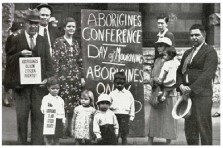WHAT ARE WE SAYING ABOUT AUSTRALIA DAY 2019? Thinking about January 26th.

Catholic Religious Australia, Australia Map
Our First Peoples are the traditional custodians of our beautiful lands and waterways and have a fundamental role in the great Australian story.

We aspire to an Australia Day that can increasingly include a recognition and celebration by all Australians of the importance of Aboriginal and Torres Strait Islanders to our nation.
January 26 has multiple meanings: it is Australia Day for some, and it is also, for some, Survival Day.
Some Aboriginal and Torres Strait Islander people and non-Aboriginal and Torres Strait Islander Australians have mixed feelings about celebrating this day - some consider it a day of mourning, and others use the day to mark the survival of their ongoing traditions and cultures.
It's important that these views are respected and that collectively we have constructive conversations about this history and seek ways to move forward together as a nation.
Our national day provides an opportunity to acknowledge and learn about our nation's past. It's a time to reflect on and learn about our national journey including the ongoing history, traditions and cultures of Aboriginal and Torres Strait Islander Peoples.
Before 1770
Aboriginal peoples had been living for more than 60 000 years on the continent we now know as Australia. At least 1600 generations of these peoples had lived and died here.

Europeans from the thirteenth century became interested in details from Asia about this land to the south. From the sixteenth century European cartographers and navigators gave the continent various names, including Terra Australis (Southern Land) and New Holland.
1. 1770
Captain James Cook raised the Union Jack on what is now called Possession Island on 22 August to claim the eastern half of the continent as New South Wales for Great Britain.
2. 1788
Captain Arthur Phillip, commander of the First Fleet of eleven convict ships from Great Britain, and the first Governor of New South Wales, arrived at Sydney Cove on 26 January and raised the Union Jack to signal the beginning of the colony.
The 1800s
1. 1804
Early almanacs and calendars and the Sydney Gazette began referring to 26 January as First Landing Day or Foundation Day. In Sydney, celebratory drinking, and later anniversary dinners became customary, especially among emancipists.

2. 1818
Governor Macquarie acknowledged the day officially as a public holiday on the thirtieth anniversary. The previous year he accepted the recommendation of Captain Matthew Flinders, circumnavigator of the continent, that it be called Australia.
3. 1838
Proclamation of an annual public holiday for 26 January marked the Jubilee of the British occupation of New South Wales. This was the second year of the anniversary’s celebratory Sydney Regatta.
4. 1871
The Australian Natives’ Association, formed as a friendly society to provide medical, sickness and funeral benefits to the native-born of European descent, became a keen advocate from the 1880s of federation of the Australian colonies within the British Empire, and of a national holiday on 26 January.

5. 1888
Representatives from Tasmania, Victoria, Queensland, Western Australia, South Australia and New Zealand joined NSW leaders in Sydney to celebrate the Centenary. What had begun as a NSW anniversary was becoming an Australian one. The day was known as Anniversary or Foundation Day.
The 1900s
1. 1901
The Australian colonies federated to form the Commonwealth of Australia. The Union Jack continued as the national flag, taking precedence over the Australian red and blue shipping ensigns gazetted in 1903. Melbourne was the interim federal capital. The Australian Capital Territory was created out of New South Wales in 1908, the federal capital named Canberra in 1913, and the Parliament House opened there in 1927.
2. 1930
The Australian Natives' Association in Victoria began a campaign to have 26 January celebrated throughout Australia as Australia Day on a Monday, making a long weekend. The Victorian government agreed with the proposal in 1931, the other states and territories following by 1935.

3. 1938
While state premiers celebrated the Sesquicentenary together in Sydney, Aboriginal leaders met there for a Day of Mourning to protest at their mistreatment by white Australians and to seek full citizen rights.
4. 1946
The Australian Natives’ Association prompted the formation in Melbourne of an Australia Day Celebrations Committee (later known as the Australia Day Council) to educate the public about the significance of Australia Day. Similar bodies emerged in the other states, which in rotation, acted as the Federal Australia Day Council.
5. 1948
The Nationality and Citizenship Act created a symbolic Australian citizenship. Australians remained British subjects.
6. 1954
The Australian blue ensign was designated the Australian national flag and given precedence over the Union Jack. The Australian red ensign was retained as the commercial shipping ensign.
7. 1979
The Commonwealth government established a National Australia Day Committee in Canberra to make future celebrations ‘truly national and Australia-wide’. It took over the coordinating role of the Federal Australia Day Council. In 1984 it became the National Australia Day Council, based in Sydney, with a stronger emphasis on sponsorship. Incorporation as a public company followed in 1990.
8. 1984
Australians ceased to be British subjects. Advance Australia Fair replaced God Save the Queen as the national anthem.
9. 1988
Sydney continued to be the centre of Australia Day spectacle and ceremony. The states and territories agreed to celebrate Australia Day in 1988 on 26 January, rather than with a long weekend. Aborigines renamed Australia Day, ‘Invasion Day’. The Bondi Pavilion protest concert foreshadowed the Survival Day Concerts from 1992.

10. 1994
Celebrating Australia Day on 26 January became established.
And, a letter challenge from The Age this week:

_________________________________________________________
